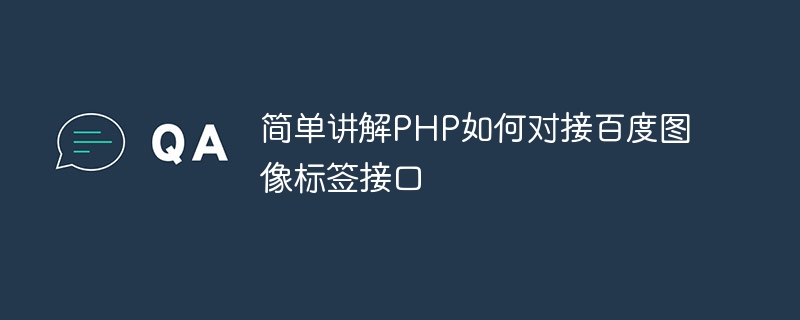

PHP is a popular server-side scripting language that is widely used in the field of web development. One common application scenario is to interface with third-party APIs to implement image tag recognition functions. This article will briefly explain how to use PHP to connect to Baidu image tag interface, and attach corresponding code examples.
First, we need to apply for and obtain the corresponding API Key and Secret Key on the Baidu Developer Platform for identity verification and access permissions.
Next, in PHP, we can use the CURL library to make HTTP requests. First, we need to initialize a CURL session and set related properties.
$url = 'https://aip.baidubce.com/oauth/2.0/token'; // 获取access_token的URL
$data = array(
'grant_type' => 'client_credentials',
'client_id' => 'Your API Key',
'client_secret' => 'Your Secret Key'
);
$options = array(
CURLOPT_URL => $url,
CURLOPT_POST => true,
CURLOPT_POSTFIELDS => http_build_query($data),
CURLOPT_RETURNTRANSFER => true,
);
$curl = curl_init();
curl_setopt_array($curl, $options);In the above code, we first specify the URL to obtain access_token. Then, an associative array $data containing the necessary parameters is defined, including grant_type, client_id and client_secret. Next, we define an $options array to configure the CURL session by setting options such as CURLOPT_URL, CURLOPT_POST, CURLOPT_POSTFIELDS, and CURLOPT_RETURNTRANSFER. Finally, use the curl_init() function to initialize a CURL session and use the curl_setopt_array() function to set CURL options.
Next, we send an HTTP POST request and get the returned access_token.
$response = curl_exec($curl); curl_close($curl); $result = json_decode($response, true); // 将返回数据解码为关联数组 $access_token = $result['access_token']; // 获取access_token
In the above code, we use the curl_exec() function to send the HTTP request and the curl_close() function to close the CURL session. Then, use the json_decode() function to decode the returned JSON data into an associative array. Finally, access_token is obtained through the associative array and saved in the $access_token variable.
Next, we can use the obtained access_token to call the Baidu image tag interface and implement the image tag recognition function.
$url = 'https://aip.baidubce.com/rest/2.0/image-classify/v2/advanced_general';
$image = file_get_contents('path/to/your/image.jpg'); // 读取图像文件内容
$data = array(
'image' => base64_encode($image),
);
$headers = array(
'Content-Type: application/x-www-form-urlencoded',
'Authorization: Bearer ' . $access_token,
);
$options = array(
CURLOPT_URL => $url,
CURLOPT_POST => true,
CURLOPT_POSTFIELDS => http_build_query($data),
CURLOPT_HTTPHEADER => $headers,
CURLOPT_RETURNTRANSFER => true,
);
$curl = curl_init();
curl_setopt_array($curl, $options);
$response = curl_exec($curl);
curl_close($curl);
$result = json_decode($response, true); // 将返回数据解码为关联数组
print_r($result); // 输出返回结果In the above code, we first specify the URL that calls the image tag interface. Then, use the file_get_contents() function to read the contents of the image file, and encode the contents using the base64_encode() function. Next, we define an associative array $data containing the image parameter, and save the encoded image data to the image parameter.
Then, we define a $headers array, which contains the Content-Type header and Authorization header of the HTTP request. The value of the Authorization header is 'Bearer' plus access_token.
Next, we define a $options array to configure the CURL session by setting options such as CURLOPT_URL, CURLOPT_POST, CURLOPT_POSTFIELDS, CURLOPT_HTTPHEADER and CURLOPT_RETURNTRANSFER. Finally, use the curl_exec() function to send the HTTP request and the curl_close() function to close the CURL session.
Finally, we use the json_decode() function to decode the returned JSON data into an associative array, and output the return result through the print_r() function.
Through the above steps, we have completed the docking of Baidu image tag interface. In this way, we can use PHP to implement image tag recognition functions and add some intelligent functions to our applications.
The above is a simple article explaining how to use PHP to connect to Baidu image tag interface. I hope it will be helpful for everyone to understand and apply PHP and image tag interfaces.
The above is the detailed content of Briefly explain how PHP connects to Baidu image tag interface. For more information, please follow other related articles on the PHP Chinese website!